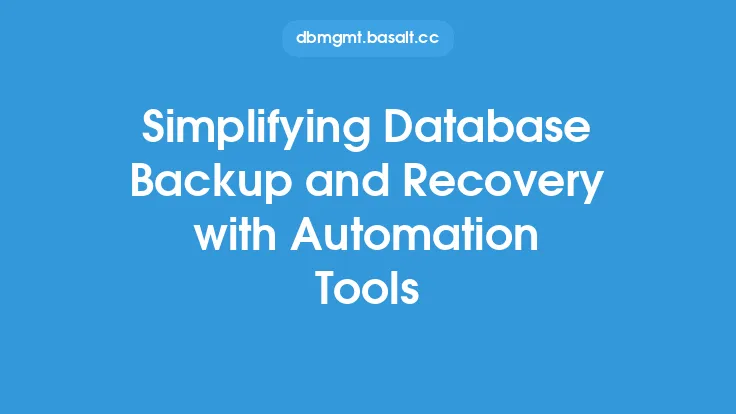When it comes to database management systems, backup automation is a crucial aspect that ensures data safety and integrity. With the increasing amount of data being generated and stored, manual backup processes can be time-consuming, prone to errors, and may not provide the required level of protection. Backup automation tools have emerged as a solution to this problem, providing a reliable and efficient way to manage database backups. In this article, we will delve into the world of backup automation tools, exploring their features, benefits, and evaluation criteria to help database administrators make informed decisions.
Introduction to Backup Automation Tools
Backup automation tools are software applications designed to automate the backup process for database management systems. These tools provide a centralized platform for managing backups, allowing administrators to schedule, monitor, and maintain backups with ease. They offer a range of features, including automated backup scheduling, data compression, encryption, and storage management. Backup automation tools support various database management systems, such as MySQL, Oracle, Microsoft SQL Server, and PostgreSQL, making them a versatile solution for diverse database environments.
Key Features of Backup Automation Tools
When evaluating backup automation tools, there are several key features to consider. These include:
- Automated backup scheduling: The ability to schedule backups at regular intervals, ensuring that data is consistently protected.
- Data compression and encryption: The ability to compress and encrypt backup data, reducing storage requirements and ensuring data security.
- Storage management: The ability to manage backup storage, including support for various storage devices and cloud storage services.
- Monitoring and reporting: The ability to monitor backup jobs and receive reports on backup status, errors, and warnings.
- Support for multiple database management systems: The ability to support various database management systems, making it a versatile solution for diverse database environments.
- Scalability and performance: The ability to handle large amounts of data and scale to meet the needs of growing databases.
Evaluation Criteria for Backup Automation Tools
When evaluating backup automation tools, there are several criteria to consider. These include:
- Ease of use: The tool should be easy to install, configure, and use, with an intuitive interface and minimal learning curve.
- Compatibility: The tool should support the database management system and operating system used in the organization.
- Scalability: The tool should be able to handle large amounts of data and scale to meet the needs of growing databases.
- Performance: The tool should be able to perform backups quickly and efficiently, without impacting database performance.
- Security: The tool should provide robust security features, including encryption and access controls, to protect backup data.
- Support and maintenance: The tool should have reliable support and maintenance options, including documentation, tutorials, and customer support.
Technical Considerations for Backup Automation Tools
When evaluating backup automation tools, there are several technical considerations to keep in mind. These include:
- Backup methods: The tool should support various backup methods, including full, incremental, and differential backups.
- Data transfer protocols: The tool should support various data transfer protocols, including FTP, SFTP, and SSH.
- Storage formats: The tool should support various storage formats, including tape, disk, and cloud storage.
- Database-specific features: The tool should provide database-specific features, such as support for database clustering, replication, and partitioning.
- Integration with other tools: The tool should be able to integrate with other tools and systems, including monitoring and management tools.
Best Practices for Implementing Backup Automation Tools
When implementing backup automation tools, there are several best practices to follow. These include:
- Developing a backup strategy: The organization should develop a comprehensive backup strategy, including backup schedules, retention policies, and disaster recovery plans.
- Configuring backup jobs: The tool should be configured to perform backups at regular intervals, with options for customizing backup schedules and settings.
- Monitoring backup jobs: The tool should be monitored regularly to ensure that backups are completing successfully and that errors are being addressed.
- Testing backups: Backups should be tested regularly to ensure that they are recoverable and that data is intact.
- Reviewing and updating backup strategies: The organization should review and update its backup strategy regularly to ensure that it remains effective and aligned with business needs.
Conclusion
Backup automation tools are a critical component of database management systems, providing a reliable and efficient way to manage database backups. When evaluating backup automation tools, it is essential to consider key features, evaluation criteria, technical considerations, and best practices. By doing so, database administrators can ensure that their organization's data is protected and that backups are performed efficiently and effectively. Whether you are managing a small database or a large enterprise environment, backup automation tools can help simplify the backup process, reduce errors, and ensure data integrity.





